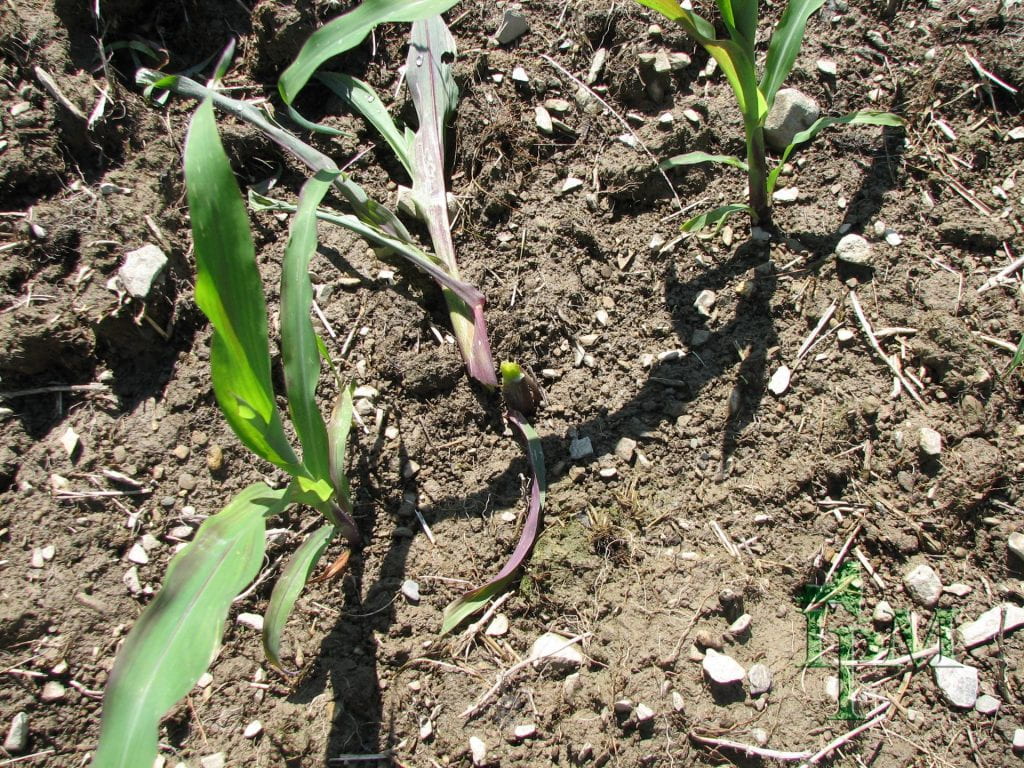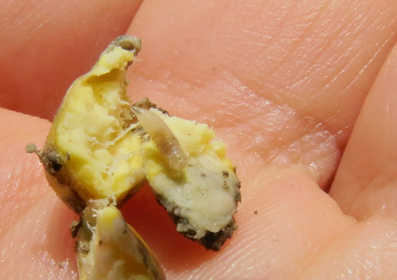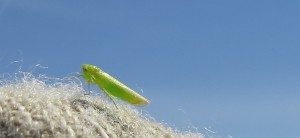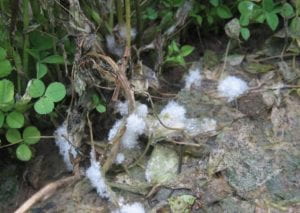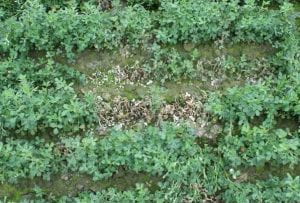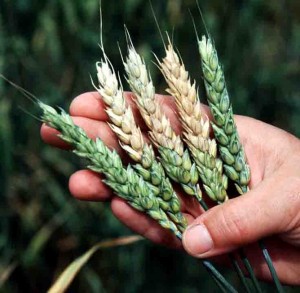Volume 18-Number 4
Contents
View from the Field
Jaime Cummings (NYS IPM) reports that some fields are drying out enough to get corn and soybean planted. In some areas of the state 1st cutting is ready in many fields but may be too wet to harvest. She also states winter malting barley fields are very uneven ranging from just in flag leaf to boot to heads emerged which will be problematic for spraying for head blight.
Janice Degni (CCE Area Agronomist) reports finding white mold in alfalfa. Jaime Cummings has prepared an article below on white mold in alfalfa.
Jeff Miller (CCE Oneida County) reports alfalfa weevil activity is starting to increase. He is finding some light damage to alfalfa. Based on degree days for alfalfa weevil, the larvae activity will increase this week across much of the state. You can predict what instar of larvae are in the field using an alfalfa degree day model:
Black cutworm moth captures continue but decreased slightly this last week. As corn is planted and it starts to emerge watch for cutworm damage in fields. The plants will be cut off at the base.
Number of Black cutworms caught by week
After fields have been tilled they are highly attractive to seed corn maggot. Make sure to use insecticide seed treatment in fields that are being tilled for planting. No-till fields are less attractive to seed corn maggot adult flies than the tilled fields. If skips in the field show after plants have emerged there is a good chance it might be seed corn maggot.
Potato leafhopper seems to make its way to NYS around Memorial Day weekend. With the storms we have been having, it may already be here. The question is “Who will be the first one to find it?”
Weather Outlook – May 24, 2019
Jessica Spaccio
NOAA Northeast Regional Climate Center
Cornell University
Last week temperatures ranged within 2 degrees of normal for most areas; 2-4 degrees above normal in the Hudson Valley. Precipitation has ranged from a trace to over 2”. Base 50 growing degree-days ranged from 10 to 90.
Slight risk for severe storms today with the main threats being damaging winds and large hail. Seasonable to above-normal temperatures this week, but with unsettled weather for most days. Memorial Day should be dry.
Today thunderstorms are likely with the potential for severe storms with damaging winds and large hail, especially during the afternoon and evening. Temperatures will be in the mid 60s to 70s with muggy conditions. Overnight lows will be in the 50s, some 40s, with a chance of showers overnight into Friday.
Friday will become mostly sunny with cooler temperatures in the 60s to low 70s. Spotty showers are possible and windy conditions are expected. Overnight temperatures will be in the 40s to low 50s.
Saturday temperatures will be in the mid 60s to 70s with higher humidity and the potential for showers and thunderstorms. Overnight temperatures will be in the 50s to near 60, a few showers are possible.
Sunday highs will be in the mid 60s to near 80 with scattered showers possible. Overnight temperatures will be in the upper 40s to upper 50s.
Monday temperatures will be in the mid 60s to upper 70s with mostly dry conditions. Overnight temperatures will be in the upper 40s to 50s with showers possible overnight.
Tuesday highs will be in the 60s to lower 70s with showers possible. Overnight temperatures will be in the 50s.
Wednesday highs will be in the mid 60s to upper 70s with showers possible. Overnight temperatures will be in the 50s.
The seven-day precipitation amounts will range from ½” to over 2 ½” .
The 8-14 day outlook (May 30 – June 5) favors below-normal temperatures for a majority of the state. Above-normal precipitation is favored for the state.
Maps of 8-14 day outlooks:
http://www.cpc.ncep.noaa.gov/products/predictions/814day/index.php
National Weather Service watch/warnings map:
US Drought Monitor
http://droughtmonitor.unl.edu/Home.aspx
Drought Impact Reporter:
https://droughtreporter.unl.edu/map/
CLIMOD2 (NRCC data interface):
http://climodtest.nrcc.cornell.edu
Sclerotinia Crown and Stem Rot on Alfalfa (AKA: White Mold)
By Jaime Cummings of NYS Integrated Pest Management, and Janice Degni of Cornell Cooperative Extension
We had an interesting report from Janice Degni (CCE, SCNY dairy and field crops team leader) this week. While out scouting and measuring alfalfa stands in Onondaga County, Janice noticed some wilting plants. Upon closer inspection, she found sclerotia, the tell-tale sign of white mold on the alfalfa stems (Fig. 1). Though this disease can be found in alfalfa and clover stands, you are likely more familiar with white mold on soybeans. Two different species of this pathogen can be found on alfalfa. Sclerotinia trifolium is the one most commonly identified on alfalfa, but the same species found on soybean, Sclerotinia sclerotiorum, can also infect alfalfa.
Figure 1. Bleached stems with sclerotia on alfalfa. (Photo by Janice Degni, CCE)
Remember that these pathogens overwinter and survive many years in the soil as sclerotia. Sclerotia are the black structures you’ve likely seen on infected soybean stems. These two different fungal pathogen species are difficult to differentiate, but the trend is that S. sclerotiorum tends to infect in the spring and summer, while S. trifolium typically infects in the fall. Regardless of the species, the symptoms, epidemiology and management are similar.
Figure 2. Sclerotinia stem and crown rot infection symptoms on alfalfa. (Photos by Carol Frate, University of California)
The symptoms of Sclerotinia crown and stem rot in alfalfa include rotting crowns, cottony growth on stems and crowns, and wilting and rotting stems. Infected crowns tend to die-off, and may be confused with winterkill, if not for the tell-tale sign of sclerotia in the dead tissues. Infection in first-year stands is most problematic. Just like in soybeans, this disease can spread quickly through a field, either by spores or via fungal mycelium spreading among plants during a cool, wet spring. This can potentially thin a stand out rather quickly, and can leave plenty of those sclerotia behind as inoculum for future years.
This prolonged cool, wet spring we’ve been experiencing has provided ideal conditions for this disease that we infrequently encounter in our alfalfa fields. An integrated management approach is the best solution. Since this disease is most prominent in first year, fall-seeded fields, you may consider future spring plantings in fields where you find it. Or, get your fall seedings in as early as possible so that seedlings have a chance to establish before the sclerotia germinate and produce spores in the fall. Tillage buries the sclerotia, which can reduce the number of spores released and may decrease infection in the field. But, as in soybeans, this disease is difficult to manage. Dense stands and weedy fields create perfect conditions for this pathogen to thrive. However, a few alfalfa varieties exist with moderate resistance, and may be considered in fields with a history of this disease. Research in other states has shown that some fungicides are efficacious against this disease when applied in the fall (Table 1). We have limited options for fungicides labeled for white mold on alfalfa in NY, including Pristine and Endura. However, fungicide applications for this disease may not be cost-effective (always follow label instructions, restrictions, and pay attention to post-harvest intervals). Herbicides, such as Paraquat, have also been used to reduce weeds and open up the canopy to increase air-flow lessen disease development.
Table 1. Results from a fungicide efficacy trial against Sclerotinia Crown and Stem Rot in Alfalfa. This table represents a partial excerpt reproduced from a table in a full publication from the University of California by C.A Frate and R.F. Long, 2005.
| Treatment | Rate/acre | Date applied | Disease Rating 1/5 | Disease Rating 2/25 | Tons/Acre 4/19 | Tons/Acre 5/20 | % Stand Remaining 5/26 |
| Untreated Control | . | . | 6.3 | 2.2 | 2.43 | 2.35 | 47.5 |
| Endura | 11 oz | 12/10 | 3.8* | 0.8* | 2.72* | 2.40 | 58.6* |
| Pristine | 18.5 oz | 12/10 | 2.8* | 1.8 | 2.78* | 2.46 | 61.7* |
| Gramoxone Max | 21.3 fl oz | 12/10 | 4.8* | 2.3 | 2.22 | 2.34 | 55.9 |
* = significantly better than the untreated control
Once the weather warms up and fields dry out, this disease will likely halt, and some infected stands may recover and produce sufficient yields in subsequent years. But, keep in mind that those sclerotia will remain in the soil for many years waiting for perfect conditions to start the disease cycle again.
Fusarium head blight commentary, May 22, 2019:
Gary Bergstrom, Extension Plant Pathologist, Cornell University
Some winter malting barley in New York is beginning to emerge from the boot and this is a critical time to consider a fungicide application. The Fusarium Risk Assessment Map (http://www.wheatscab.psu.edu/riskTool.html) indicates a moderate to high risk of Fusarium head blight (FHB) for several areas of New York. Maximal suppression of FHB and grain contamination by deoxynivalenol (DON) mycotoxin results when fully emerged heads of winter malting barley are sprayed with full label rates of Caramba or Prosaro fungicides. A heads emerged spray with these triazole fungicides also helps protect upper leaves against fungal leaf blotches, powdery mildew, and rust. Foliar sprays of Caramba or Prosaro up to seven days after head emergence may still result in significant FHB and DON suppression. Unfortunately, Miravis Ace, a new fungicide product with activity against FHB, will not receive NYSDEC label approval in time for use on small grain crops this season. Fungicide products containing strobilurins should not be applied to headed wheat or barley as they may result in increased levels of DON in grain.
Winter wheat is generally a week or more behind in development from winter barley planted on the same fall date. Winter wheat in New York varies from stem elongation to flag leaf visible stages. We should reach the critical fungicide application window for winter wheat over the next two weeks. The triazole products Caramba and Prosaro are the most effective fungicides for suppression of FHB and DON contamination when applied at flowering (emergence of yellow anthers on heads). A flowering application of triazole fungicide should be based on Fusarium head blight (FHB) risk as well as the risks of powdery mildew, rusts, and fungal leaf blotches in the upper canopy based on scouting of individual fields. There is an application window of approximately 7 days from the beginning of flowering in which reasonable FHB suppression can be expected. Check the Fusarium Risk Assessment Tool (http://www.wheatscab.psu.edu/) and your local weather forecast frequently as your winter wheat crop approaches heading and flowering.
Black Cutworm Moth Captures
| County | Town | April 21-28 | Apr. 30 -May 5 | May 6-12 | May 13-19 |
| Delaware | Davenport Center | NA | 0 | 6 | 16 |
| Dutchess | Amenia | NA | 5 | 29 | 45 |
| Lewis | Martinsburg | NA | 0 | 93 | 84 |
| Livingston | Caledonia | NA | 0 | 4 | 4 |
| Livingston | Lima | NA | 3 | 5 | 10 |
| Oneida | Kirkland | NA | 4 | 4 | 35 |
| Oneida | Westmorland | NA | 0 | 9 | 3 |
| Onondaga | Memphis | NA | 0 | 0 | 0 |
| Seneca | Seneca Falls | 12 | 29 | 64 | 35 |
| Tompkins | Ulysses | NA | 5 | 6 | 0 |
| Washington | Argyle | NA | 0 | 0 | 0 |
| Washington | Easton | NA | 0 | 4 | 3 |
| Washington | Fort Edward | NA | 1 | 3 | 2 |
| Washington | Stillwater | NA | 3 | 4 | 3 |
| Wayne | Ontario | 1 | 1 | 5 | 4 |
| Wyoming | Castile | 0 | 19 | 42 | 15 |
| TOTAL | 13 | 70 | 278 | 259 |
True Armyworm Moth Captures
| County | Town | April 21-28 | Apr. 30 -May 5 | May 6-12 | May 13-19 |
| Dutchess | Amenia | NA | 0 | 0 | 0 |
| Delaware | Davenport Center | NA | 0 | 0 | 0 |
| Livingston | Lima | NA | 1 | 2 | 8 |
| Oneida | Kirkland | NA | 0 | 1 | 0 |
| Oneida | Westmorland | NA | 0 | 3 | 2 |
| Onondaga | Memphis | NA | 0 | 0 | 1 |
| Lewis | Martinsburg | NA | 0 | 0 | 0 |
| Livingston | Caledonia | NA | 1 | 0 | 2 |
| Washington | Argyle | NA | 0 | 0 | 0 |
| Washington | Easton | NA | 0 | 0 | 0 |
| Seneca | Seneca Falls | 0 | 0 | 12 | 2 |
| Wayne | Ontario | 0 | 0 | 0 | 0 |
| Tompkins | Ulysses | NA | 0 | 0 | 0 |
| Wyoming | Castile | 0 | 0 | 0 | 2 |
| TOTAL | 0 | 1 | 7 | 17 |
New York Field Crop Pest Degree Day Accumulations for selected locations
(May 27, 2019)
| Station Location |
Alfalfa Weevil (Base 48) March 1 |
GDDs (Base 50 F) March 1 |
Seed Corn Maggot (base 39) January 1 |
Black Cutworm (Base 50) April 24 |
| Ceres | 345 | 266 | 824 | 271 |
| Chazy | 198 | 150 | 556 | 116 |
| Geneva | 298 | 226 | 755 | 176 |
| Highland | 447 | 360 | 985 | 243 |
| Ithaca | 337 | 253 | 820 | 179 |
| Massena | 208 | 148 | 567 | 124 |
| Northport (Richters) | 474 | 376 | 1067 | 264 |
| Valatie | 386 | 308 | 880 | 215 |
| Versailles | 327 | 251 | 826 | 185 |
| Watertown | 171 | 120 | 569 | 98 |
Accumulated Degree Days for Peak Occurrence (50%) of Alfalfa Weevil at a given Life Stages
Stage Degree Days
Egg hatch 280 DD
Instar 1 315 DD
Instar 2 395 DD
Instar 3 470 DD
Instar 4 550 DD
Cocooning 600 DD
Pupa 725 DD
Adult emergence 815 DD
Black Cutworm Degree Days Relative to Life Stages
| Degree Days | Stage | Feeding Activity |
| 0 | Moth Capture | Egg Laying |
| 90 | Eggs Hatch | |
| 91-311 | 1st to 3rd Instar | Leaf Feeding |
| 312-364 | 4th Instar | Cutting Begins |
| 365-430 | 5th Instar | Cutting Begins |
| 431-640 | 6th Instar | Cutting Slows |
| 641-989 | Pupa | No feeding |
Source: University of Minnesota Black Cutworm Trapping Network
Seed Corn Maggot Peak Flight and Fly Maggot Free Degree Days
| Base Temp = 390 F | Peak 1st Generation | Seed corn maggot fly free degree days | Peak 2nd Generation | Seed Corn maggot fly free degree days | Peak 3rd Generation | Seed Corn Maggot fly Free degree days |
| degree days | 360 | 810 | 1,080 | 1530 | 1800 | 2250 |
Source: Insect IPM for Organic Field Crops: Seed Corn Maggot
Clipboard Checklist
Keith Waldron, NYS IPM
General
*Pre- and post-plant weed evaluation, timing cultivation and/or post-emergent weed management
*Watch for early season weeds: winter annuals, chickweed, henbit, field penny cress, shepherd’s purse, giant and common ragweed, purple deadnettle, lambsquarters, redroot pigweed, velvet leaf, Pennsylvania smartweed, common sunflower, quackgrass, foxtail
Alfalfa:
*Evaluate established legume stands for harvest.
*Monitor for alfalfa weevil, crown or foliar diseases
*Monitor new seedings for Pythium blight and Phytopthora Root Rot.
*Monitor for Alfalfa Snout Beetle (In Oswego, Jefferson, Cayuga, Wayne, Lewis, St. Lawrence, Clinton, Essex, and Franklin counties)
Small Grains:
*Monitor winter grain fields for growth stage, disease presence or risk, weed issues (such as winter annuals, corn chamomile and chickweed), growth stage, number of tillers
* Evaluate stands for risk of fungal diseases (See above Dr. Bergstrom’s article above)
*Check stands for soilborne virus diseases, Wheat spindle streak mosaic and Soilborne wheat mosaic, check for signs of powdery mildew or other maladies, cereal leaf beetle, weed escapes, goose damage
Corn:
*Plant corn as conditions allow
*Pre- and post-plant weed evaluation, timing cultivation and/or pre- and post-plant weed management
*Emergence: assess stand, population count, bird and early season insect issues e.g. black cutworm, wireworm, white grubs.
Soybeans:
*Plant soybeans as conditions allow
*Pre- and post-plant weed evaluation, timing cultivation and/or post emergence weed management
*Emergence: assess stand, population count
Pastures:
*Check and mend fences as needed.
*Check crop growth
*Monitor fields for invasive species, plants harmful to livestock
*Review/Plan rotation system
Equipment:
*Remove / clean soil and crop debris from equipment
*Arrange for custom weed control or check your own application or cultivator equipment for repairs.
*Carry appropriate / necessary NYS DEC and EPA required documents: (pesticide applicators license, pesticide labels, MSDS sheets, etc.) with application equipment
*Calibrate:
-planting equipment – maintain records on planting rate per field
-manure spreaders – maintain records on amount spread per field
-pesticide application equipment – Check nozzles, pumps, etc., recalibrate pesticide application equipment before use.
Storage:
* Check stored grain bins for temperature, moisture and signs of mold and insects. Aerate, core, transfer grain or treat as necessary
*Check forage allocation and anticipate feed program adjustments as forages from previous year are used up
*Plan where forages should be stored for optimum allocation next feeding season



